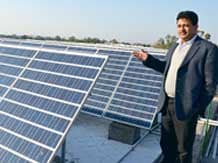 |
| Santosh Kumar, Director, Science and Technology, Union Territory of Chandigarh |
Other entrepreneurs in the region have already embarked on this road.
Vikram Hans, managing director of Multi Overseas India Private Limited, Chandigarh, said that owing to the increase in opportunities in solar power generation, he is manufacturing solar power inverters with high charging capacity. "There is huge demand from the telecom sector, as solar gen-sets are more cost effective than diesel gen-sets. Solar power is not an option but a strategic compulsion now. So there is a lot of scope for business expansion."
Jagat Jawa, director general of the Solar Energy Society of India, said that due to a fall in the cost of solar power generation in the past four to five years, the business had become lucrative for SMEs. "Four years back the Central Electricity Regulatory Commission had fixed the tariff of solar power at Rs 17.91 per unit, and this has now decreased to one-third. SMEs can make modules, solar cells, cables and small electronic parts. They can register as channel partners with the ministry of new and renewable energy to avail of business opportunities."
The Jawaharlal Nehru National Solar Mission launched in January 2010 by the Union government has set the ambitious target of deploying 20,000 Mw of grid-connected solar power by 2022. One of the ways through which the mission aims to reduce the cost of solar power generation in the country is through domestic production of critical raw materials, components and products. This is expected to open new opportunities for small and medium entrepreneurs.
"There is a huge demand-supply gap in the availability of grid-tied photovoltaic inverters and bi-directional electricity meters. Most of these are either imported or provided by the big players, and are expensive. SMEs can make use of available technologies to manufacture such items. This would not only cut the government's import bill but also slash the cost of power generation," said Santosh Kumar, director, Science and Technology, Union Territory of Chandigarh, and also the director of CREST (Chandigarh Renewal Energy and Science & Technology Promotion Society).
Chandigarh is one of the four model solar cities (the others are Nagpur, Pune and Mysore) selected by the Union government for setting up rooftop solar photovoltaic power systems. In a model solar city, a subsidy of either 50 per cent of the project cost or Rs 19 crore is given for solar power generation.
Uni-directional meters are used when the power is drawn from the grid. But in case of power generation by the consumer, a bi-directional meter is required which can register the electricity consumed and can also measure the surplus power supplied to the grid by the consumer. Such meters are presently available at an exorbitant price (about Rs 20,000 each). These meters can be sourced at a third of the price if manufactured by SMEs, added Santosh Kumar.
SMEs can also manufacture grid-tied invertors. These inverters can 'sense' the grid. When the grid shuts down, they divert power from the grid to the battery, saving power.
The Energy and Resources Institute (TERI) has been conducting a high-resolution satellite imaging survey to develop a web-based GIS tool for assessing the availability of rooftop space and radiation in Chandigarh. Amit Kumar, director (energy-environment) at TERI, said that SMEs can start making photovoltaic inverters, charge controllers, electrical components and metallic mounting structures.
With the tariffs for conventional power increasing owing to the high cost of coal and diesel, and the cost of renewable energy declining owing to the availability of better technologies, India is expected to reach grid parity (when the cost of renewable and conventional power equalises) by 2017. And since the Indian climate supports solar power generation, the investment in this field would be sustainable.
Source: http://www.business-standard.com/article/sme/solar-power-a-lucrative-new-opportunity-for-punjab-smes-113123000971_1.html
No comments:
Post a Comment